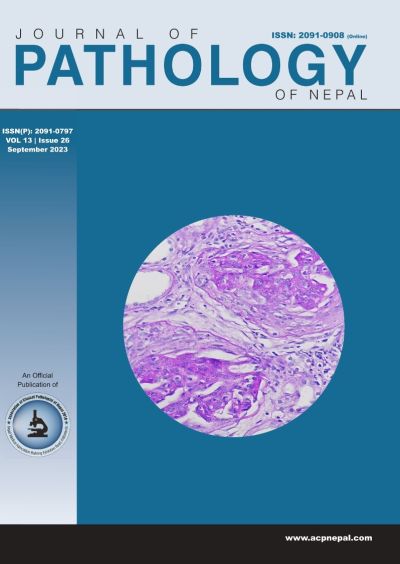Study of nuclear morphometry in the cytologic evaluation of thyroid neoplasms
DOI:
https://doi.org/10.3126/jpn.v13i2.55485Keywords:
Nuclear morphometry; Papillary carcinoma; Medullary carcinoma; Thyroid neoplasmAbstract
Background: Nuclear morphometry is purported to allow better differentiation between various thyroid lesions beyond what is offered by conventional cytology. The present study was conducted to evaluate the nuclear morphometric parameters in fine needle aspirates of thyroid neoplasms and to study their role in differentiating benign and malignant thyroid neoplasms.
Materials and Methods: Nuclear morphometric parameters of all the patients presenting with thyroid swelling and undergoing fine needle aspiration cytology (FNAC) and belonging to Category III, IV, V, and VI of the Bethesda System for Reporting Thyroid Cytopathology (TBSRTC) were studied.
Results: Out of a total of 60 cases, a maximum was noted from category IV which is follicular neoplasm or suspicious for follicular neoplasm. The sensitivity of FNAC for the diagnosis of thyroid lesions in the present study was observed at 87.71%. The nuclear morphometry parameters – short axis diameter, long axis diameter, nuclear area, and perimeter showed significant differences between benign and malignant lesions (p-value <0.001). The mentioned nuclear morphometric parameters were observed to be the highest in anaplastic carcinoma followed by papillary carcinoma and medullary carcinoma, and lowest in follicular neoplasms. A significant difference was observed in the nuclear parameters of follicular adenoma and follicular carcinoma.
Conclusions: Nuclear morphometry can help in distinguishing between benign and malignant thyroid lesions, particularly in the diagnosis of indeterminate smears where there is a disparity in diagnosis on conventional cytology, especially in differentiating follicular neoplasms.
Downloads
Downloads
Published
How to Cite
Issue
Section
License
Copyright (c) 2023 The Author(s)

This work is licensed under a Creative Commons Attribution 4.0 International License.
This license enables reusers to distribute, remix, adapt, and build upon the material in any medium or format, so long as attribution is given to the creator. The license allows for commercial use.




